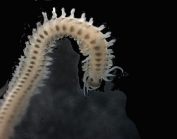WoRMS name details
Phyllodoce (Anaitides) mucosa Örsted, 1843
130679 (urn:lsid:marinespecies.org:taxname:130679)
alternative representation
Species
marine
Not documented
Distribution A. mucosa occurs near the Dutch coast, from the Voordelta in the south to the Dutch Wadden islands in the north, where the...
Nomenclature Often regarded as Phyllodoce (Anaitides) mucosa
Distribution A. mucosa occurs near the Dutch coast, from the Voordelta in the south to the Dutch Wadden islands in the north, where the species is most abundant. In contrast to A. groenlandica this species is present in the eastern and western part of the Wadden Sea as well as in the Delta area. [details]
Nomenclature Often regarded as Phyllodoce (Anaitides) mucosa
Nomenclature Often regarded as Phyllodoce (Anaitides) mucosa [details]
Read, G.; Fauchald, K. (Ed.) (2025). World Polychaeta Database. Phyllodoce (Anaitides) mucosa Örsted, 1843. Accessed through: World Register of Marine Species at: https://www.marinespecies.org/aphia.php?p=taxdetails&id=130679 on 2025-04-06
Date
action
by
![]() The webpage text is licensed under a Creative Commons
Attribution 4.0 License
The webpage text is licensed under a Creative Commons
Attribution 4.0 License
Nomenclature
basis of record
Harms, J. (1993). Check list of species (algae, invertebrates and vertebrates) found in the vicinity of the island of Helgoland (North Sea, German Bight): a review of recent records. <em>Helgoländer Meeresunters.</em> 47: 1-34. [p. 25, tab. 3: Gastrosaccus spinifer, Mysis relicta, Praunus inermis, Schistomysis kervillei, Schistomysis spiritus. (look up in IMIS) [details]
Taxonomy
status source
Pleijel, Fredrik. (1991). Phylogeny and classification of the Phyllodocidae (Polychaeta). <em>Zoologica Scripta.</em> 20(3): 225-261., available online at https://doi.org/10.1111/j.1463-6409.1991.tb00289.x [details] Available for editors  [request]
[request]
status source Pleijel, F. (1988). <i>Phyllodoce</i> (Polychaeta, Phyllodocidae) from Northern Europe. <em>Zoologica Scripta.</em> 17(2): 141-153., available online at http://dx.doi.org/10.1111/j.1463-6409.1988.tb00091.x [details] Available for editors [request]
[request]
status source Pleijel, F. (1988). <i>Phyllodoce</i> (Polychaeta, Phyllodocidae) from Northern Europe. <em>Zoologica Scripta.</em> 17(2): 141-153., available online at http://dx.doi.org/10.1111/j.1463-6409.1988.tb00091.x [details] Available for editors
Other
context source (Deepsea)
Intergovernmental Oceanographic Commission (IOC) of UNESCO. The Ocean Biogeographic Information System (OBIS), available online at http://www.iobis.org/ [details]
additional source Hartmann-Schröder, G. (1996). Annelida, Borstenwürmer, Polychaeta [Annelida, bristleworms, Polychaeta]. <em>2nd revised ed. The fauna of Germany and adjacent seas with their characteristics and ecology, 58. Gustav Fischer: Jena, Germany. ISBN 3-437-35038-2.</em> 648 pp. (look up in IMIS) [details] Available for editors [request]
[request]
additional source Bellan, G. (2001). Polychaeta, <i>in</i>: Costello, M.J. <i>et al.</i> (Ed.) (2001). European register of marine species: a check-list of the marine species in Europe and a bibliography of guides to their identification. <em>Collection Patrimoines Naturels.</em> 50: 214-231. (look up in IMIS) [details]
additional source Muller, Y. (2004). Faune et flore du littoral du Nord, du Pas-de-Calais et de la Belgique: inventaire. [Coastal fauna and flora of the Nord, Pas-de-Calais and Belgium: inventory]. <em>Commission Régionale de Biologie Région Nord Pas-de-Calais: France.</em> 307 pp., available online at http://www.vliz.be/imisdocs/publications/145561.pdf [details]
additional source Hartmann-Schröder, G. (1996). Annelida, Borstenwürmer, Polychaeta [Annelida, bristleworms, Polychaeta]. <em>2nd revised ed. The fauna of Germany and adjacent seas with their characteristics and ecology, 58. Gustav Fischer: Jena, Germany. ISBN 3-437-35038-2.</em> 648 pp. (look up in IMIS) [details] Available for editors
additional source Bellan, G. (2001). Polychaeta, <i>in</i>: Costello, M.J. <i>et al.</i> (Ed.) (2001). European register of marine species: a check-list of the marine species in Europe and a bibliography of guides to their identification. <em>Collection Patrimoines Naturels.</em> 50: 214-231. (look up in IMIS) [details]
additional source Muller, Y. (2004). Faune et flore du littoral du Nord, du Pas-de-Calais et de la Belgique: inventaire. [Coastal fauna and flora of the Nord, Pas-de-Calais and Belgium: inventory]. <em>Commission Régionale de Biologie Région Nord Pas-de-Calais: France.</em> 307 pp., available online at http://www.vliz.be/imisdocs/publications/145561.pdf [details]
 Present
Present  Present in aphia/obis/gbif/idigbio
Present in aphia/obis/gbif/idigbio  Inaccurate
Inaccurate  Introduced: alien
Introduced: alien  Containing type locality
Containing type locality
Unreviewed
Biology The species deposits its eggs in green gelatinous cocoons at the surface of mud flats and probably also on the bottom of tidal channels.
In the Delta area these egg capsules may be found from the first weeks of March until the first weeks of June. A second period of spawning occurs in October-November. The larvae become free-swimming after two days to three weeks and seem to have a planktonic life of several weeks.
A. mucosa, like most phyllodocids, is presumably a predatory carnivore, but this species is also reported as being a scavenger, feeding on animal remains (Hartmann-Schröder, 1971; Wolff, 1973; Fauchald & Jumars, 1979). [details]
Distribution A. mucosa occurs near the Dutch coast, from the Voordelta in the south to the Dutch Wadden islands in the north, where the species is most abundant. In contrast to A. groenlandica this species is present in the eastern and western part of the Wadden Sea as well as in the Delta area. [details]
Habitat A. mucosa is abundant in the fine sand areas of the Dutch Continental Shelf. It is also reported from rnuddy sediment, mixed with sand, shell fragments and stones, and in mussel beds. Compared to A. groenlandica, this species inhabits the muddier types of sediment. It is suggested that one species forces the other into a different type of sediment by competition (Hartmann-Schröder, 1971; Wolff, 1973; Hayward & Ryland, 1990). [details]
Morphology This species resembles A. groenlandica, but differs by the shape of the lamellae on the parapodia and its smaller dimensions. lt can reach 50 mm in length and 250 segments. A. mucosa is whitish or yellowish in colour, with transverse dark brown bands or patches. The species shows a strong production of mucus (Hartmann-Schröder, 1971; Hayward & Ryland, 1990). [details]
Nomenclature Often regarded as Phyllodoce (Anaitides) mucosa [details]
